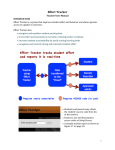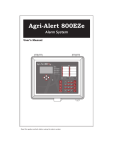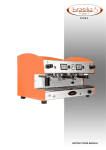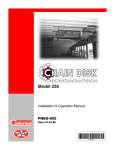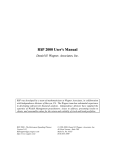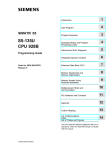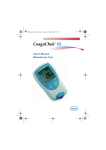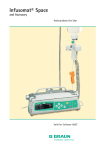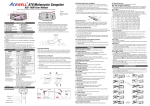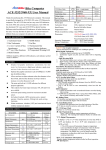Download APCD-500 - Farmer Boy Ag Systems
Transcript
Chain Disk Controller APCD-500 User's Manual TABLE OF CONTENTS 1. PRECAUTIONS ..................................................... 4 2. TERMS AND SYMBOLS ......................................... 5 3. INSTALLATION .................................................... 7 3.1 Mounting Instructions ...................................................... 7 3.2 Connections .................................................................. 7 4. CONTROLLER'S OPERATION ................................. 8 4.1 Controller's Description ................................................... 8 4.2 Feeder Setup ................................................................. 9 4.2.1 4.2.2 4.2.3 4.3 Feed Distribution Modes ................................................ 12 4.3.1 4.3.2 4.4 Timed Feed Distribution ............................................................ 12 Continuous Feed Distribution Method .......................................... 12 Proximity Sensor Location .............................................. 12 4.4.1 4.4.2 4.5 Cascade Setup ........................................................................... 9 Independent Feeders with a Common Auger ............................... 10 Independent Feeders with Individual Augers ................................ 11 In Timer Mode .......................................................................... 12 In Continuous Mode .................................................................. 12 Filling Chain Disk Feeders ............................................... 13 4.5.1 Operation of the Bin Auger ........................................................ 13 4.5.2 Filling Process ........................................................................... 14 4.5.2.1 Filling Cascaded Feeders ..................................................... 15 4.5.2.2 Filling Independent Feeders with a Common Bin Auger .......... 18 4.5.2.3 Filling Independent Feeders with Individual Bin Augers ........... 21 2 4.6 Feed Delivery Process ................................................... 24 4.7 Feed Cycles ................................................................ 25 APCD-500 rev.01 APCD-500 5. PARAMETER SETTINGS ...................................... 26 5.1 Controller Status .......................................................... 26 5.2 Run Time History .......................................................... 27 5.3 Time & Date ................................................................ 28 5.4 Feed Cycle Settings ...................................................... 29 5.5 Run Time Settings ....................................................... 31 5.6 Installation Setup ......................................................... 32 5.7 Manual & Test Modes ................................................... 38 5.7.1 5.7.2 5.7.3 5.7.4 5.7.5 5.7.6 5.8 Manual Filling of the Feeders ..................................................... 38 Manual Start / Stop .................................................................. 39 Bypassing a Feeder ................................................................... 39 Manual Dump ........................................................................... 40 Toggle Switch .......................................................................... 40 Test Mode ................................................................................ 41 Alarms ....................................................................... 42 5.8.1 Acknowledging an alarm ........................................................... 43 6. TECHNICAL SPECIFICATIONS .............................. 44 7. MEMORY CARD ................................................. 45 8. INDEX .............................................................. 47 Thevco Electronics 5200, Armand-Frappier St-Hubert (Quebec) Canada J3Z 1G5 APCD-500 rev.01 3 1. PRECAUTIONS Although fuses at the input and outputs of the controller protect its circuits in case of an overload or overvoltage, we recommend installing an additional protection device on the controller's supply circuit. The room temperature where the controller is located MUST ALWAYS REMAIN BETWEEN 32°F AND 104°F (0°C TO 40°C). For indoor use. To avoid exposing the controller to harmful gases or excessive humidity, it is preferable to install it in a corridor. DO NOT SPRAY WATER ON THE CONTROLLER FOR CUSTOMER USE Enter the serial number located on the side of the controller below for future reference. Model number: Serial number: 4 APCD-500 rev.01 APCD-500 2. TERMS AND SYMBOLS LCD DISPLAY OUTPUT STATUS FUNCTIONS ARROW KEYS MENU SELECT BUTTONS LCD Display: The LCD display on the left gives the current readings and parameters to be adjusted when you select a function. The three keys at the right of the display are used to edit parameters and to navigate through the screen display. When the parameters for a given function cannot all be presented at once on the display, arrows are displayed on the right hand side to indicate that additional parameters can be displayed using the ar. After 4 minutes of inactivity, the display returns to the row keys STATUS display. Arrow keys: The arrow keys that are located next to the LCD display have 2 purposes. They are first used to step through the parameters that are displayed on the display. They are also used to modify a parameter's value when a parameter flashes on the display. Menu Select Buttons: These keys are used to select the functions that are located in the main menu. Adjusting a parameter: Use the arrow keys to select the parameter that needs to be adjusted. Once the parameter is selected, press MODIFY. The parameter then flashes on the display. It can now be adjusted with the arrow keys. Once it is properly set, Press MODIFY once again to validate the new value. If the value does not flash after having pressed the MODIFY, it means that the value is a reading. A reading cannot be modified. APCD-500 rev.01 5 APCD-500 Status LEDs The LEDs at the right of the control panel give the status of each output. The following table gives the meaning of each pilot light: LED MEANING ALARM Turns on when an alarm is detected. The feeding system stops operating until the alarm is acknowledged. CURRENT OVERLOAD Flashes when the amperage draw of the APCD-500 feeder has exceeded the Max Current limit for the Overload Delay or flashes when this occurs to a slave feeder (APCD-500-S). Fix the problem then press and hold the RESET button to restart the system. CHAIN DISK SAFETY SWITCH Turns on when the drive unit of the APCD-500 has reached its safety switch; flashes when this occurs to a slave feeder (APCD-500-S). MAX RUN TIME Turns on when the run time of the APCD-500 feeder exceeds the Max Run Time parameter value (only if a proximity sensor is used); flashes when this occurs to a slave feeder (APCD500-S). FEED SWITCH Turns on when the proximity sensor detects feed. Flashes during the Feed Bypass Delay. CHAIN DISK OUTPUT Turns on when the master Chain Disk feeder is running. AUGER OUTPUT Turns on when the bin auger is running; Flashes during the Auger Delay . ACTUATOR OPEN Turns on when the dumps are opened. ACTUATOR CLOSE Turns on when the dumps are closed. MANUAL MODE Turns on when an output is manually controlled. AUTOMATIC MODE Turns on when the automatic control mode is active. SYMBOLS Double insulation 6 APCD-500 rev.01 :$51,1* Caution, risk of danger 3. INSTALLATION 3.1 Mounting Instructions Remove the four screws in the front cover and lift the cover. Remove the black caps located on the three mounting holes. Mount the enclosure to the wall using three screws. Be sure the electrical knockouts are at the bottom of the enclosure in order to prevent water from entering the controller. Insert the screws into the mounting holes and tighten. Fasten the black caps onto the mounting holes. 3.2 Connections To connect the controller, refer to the wiring diagram enclosed with this user's manual. Use the electrical knockouts provided at the bottom of the enclosure. Do not make additional holes in the enclosure, particularly on the side of the enclosure when using a computer communications module. • • • • • • • :$51,1* Do not install rigid conduit into electrical knockouts. Only nylon cable glands are permitted for cable or wire fastening. A switch or circuit breaker shall be included in the building installation. It shall be in close proximity to the equipment and within easy reach of the operator. It shall be marked as the disconnecting device for the equipment. The main supply circuit breaker for feeder motor (L1/L2 POWER IN) shall be 20 A. Wire gage used for mains supply (L1/L2 POWER IN) and feeder motor shall be at least 12 AWG. Separate circuit breaker shall be used for auger motor. The mains supply breaker for auger motor shall be 15 A. Wire gage used for auger motor shall be at least 14 AWG. ALL WIRING MUST BE DONE BY AN AUTHORIZED ELECTRICIAN AND MUST COMPLY WITH APPLICABLE CODES, LAWS AND REGULATIONS. BE SURE POWER IS OFF BEFORE DOING ANY WIRING TO AVOID ELECTRICAL SHOCKS AND EQUIPMENT DAMAGE. Safety may be jeopardized if the equipment is used in a manner not specified by the manufacturer. APCD-500 rev.01 7 4. CONTROLLER'S OPERATION 4.1 Controller's Description The APCD-500 controls the feed entry into Chain Disk feeders and the distribution of feed to the animals. When used in combination with APCD-500-S auxiliary units, this controller can control up to 8 Chain Disk feeders. Due to its great number of options, the APCD-500 controller can suit most Chain Disk setups: - Timed or continuous feed cycles; - With or without proximity sensors at the end of the feeders; - With or without actuators / electric valves to open the drops; - With one or multiple bin augers; - With one or multiple Chain Disk feeders; - With cascade or independent Chain Disk setups. 4 8 APCD-500 rev.01 APCD-500 4.2 Feeder Setup Up to 7 slave units (APCD-500S) can be used to drive additional Chain Disk feeders. These supplementary feeders can share common bin augers, they can be linked together, or they can operate independently one from another. The following section explains the three possible feeder setups that can be managed by the controller. Refer to the Installation Setup chapter to select your specific feeder setup. 4.2.1 Cascade Setup In this setup, all feeders are connected together and share a common bin auger. When this auger starts bringing feed into the feeders, all drive units start running to send feed towards the farthest Chain Disk feeder (APCD-500-S unit with the highest ID number). When this feeder is filled-up, feed then goes toward the preceding feeder, etc. Refer to section 4.5.2.1 to get information about the filling process in this feeder setup. Feeders Filling Order Controller & ID number First APCD-500-S ID #3 Second APCD-500-S ID #2 Third APCD-500-S ID #1 Last APCD-500 MASTER Bins APCD-500 rev.01 9 APCD-500 4.2.2 Independent Feeders with a Common Auger Independent feeders that share a common bin auger are filled following the numerical order: the master Chain Disk feeder is filled first, followed by slave feeder #1, slave feeder #2, etc. Feeders Filling Order Controller & ID number Last APCD-500-S ID #3 Third APCD-500-S ID #2 Second APCD-500-S ID #1 Bins First APCD-500 MASTER Refer to section 4.5.2.2 to get information about the filling process in this feeder setup. 10 APCD-500 rev.01 APCD-500 4.2.3 Independent Feeders with Individual Augers Independent feeders that all have their own bin auger are being filled simultaneously when a feed cycle starts. Each feeder filled according to its respective parameter settings. Feeders Filling Order Controller & ID number Bins Simultaneous APCD-500-S ID #3 Simultaneous APCD-500-S ID #2 Simultaneous APCD-500-S ID #1 Simultaneous APCD-500 MASTER Refer to section 4.5.2.3 to get information about the filling process in this feeder setup. APCD-500 rev.01 11 APCD-500 4.3 Feed Distribution Modes 4.3.1 Timed Feed Distribution When feed is distributed according to a timer, the user chooses at what time the feeders start being filled and at what time feed starts being delivered to the animals. Up to daily 20 feed cycles can be programmed. Refer to section 5.6 to enable the timed feed distribution method. 4.3.2 Continuous Feed Distribution Method The continuous feeding method allows filling the feeders from the moment they are empty: when the proximity sensor located at the end of the master Chain Disk feeder stops detecting feed, a delay is launched to restart filling all feeders. 4.4 Proximity Sensor Location Proximity sensors are used to detect the presence and absence of feed at the end of the feed lines. 4.4.1 In Timer Mode When feed is distributed according to a timer, optional proximity sensors can be used to stop the entry of feed when feed is detected at the end of the feed line (see illustration). If proximity sensors are used, one sensor must be located at the end of each feeder. 4.4.2 In Continuous Mode drive unit proximity sensor last drop drive unit When using the continuous feed distribution mode, a proximity sensor must be located in the tube of the last drop of each feeder. proximity sensor last drop 12 APCD-500 rev.01 APCD-500 4.5 Filling Chain Disk Feeders 4.5.1 Operation of the Bin Auger At the start-up of each feeding cycle, right after the Auger's Delay has elapsed, the bin auger starts bringing feed into the feeders and stops when the feeder is loaded. There are two ways the controller can detect that a feeder is full: FEED LINE 1. The proximity sensor located at the end of the line detects feed for 5 seconds without interruption; 2. The drive unit has been running for the Max Run Time parameter value (only if no proximity sensor is used). Chain Disk Overload Protection: The controller monitors the amperage draw of Chain Disk drive units to prevent overloading the system. If the amperage exceeds the limit (Max Current Consumption), the controller will temporarily shut down the bin auger while the Chain Disk keeps running in order to discharge the feed. As the feed load decreases the amperage draw also decreases; the bin auger restarts when the current consumption gets lower than the Max Current Consumption - Window Size. Refer to section 5.6 to set bin auger parameters APCD-500 rev.01 13 APCD-500 4.5.2 Filling Process The filling process of Chain Disk feeders is based on two factors: 1. Feeder setup: - Cascade setup; - Independent feeders with a common bin auger; - Independent feeders with individual bin augers. 2. Feed Distribution Mode: - Continuous feed distribution; - Timed feed distribution. The following sections explain all possible ways Chain Disk feeders can be filled. Refer to the section that suit your particular feeder setup and feed distribution method. :$51,1* 14 PLEASE NOTE THAT THE WHOLE FEEDING SYSTEM STOPS WHEN AN ALARM IS ACTIVE! APCD-500 rev.01 APCD-500 4.5.2.1 Feeders Filling Cascaded Feeders Filling Order Controller & ID number First APCD-500-S ID #3 Second APCD-500-S ID #2 Third APCD-500-S ID #1 Last APCD-500 MASTER Bins Cascade Setup Option A – Continuous Feed Distribution 1. Beginning the Filling Process: The filling process starts when the Continuous Delay has elapsed (this delay is launched when the proximity sensor located in the last drop of the master Chain Disk feeder stops detecting feed). 2. Emptying the Feeders: Once the Continuous Delay has elapsed, the controller activates all drive units during the Auger Delay to make sure all feeders are empty before bringing new feed. 3. Filling the Farthest Chain Disk Feeder: When the Auger Delay has elapsed, all drive units keep running while the bin auger brings feed into the feeders. Feed is first directed towards the farthest feeder (Chain Disk with the highest ID number). APCD-500 rev.01 15 APCD-500 4. The Farthest Feeder is Full: The controller knows the farthest feeder is full when the proximity sensor located at its end detects feed for 5 seconds without interruption. When feed is detected, the drive unit of the loaded feeder stops and all other feeders continue running until they are all full. 6. The Last Feeder is Full: When the last feeder is loaded (last feeder = master Chain Disk feeder), the bin auger stops and all drive units are off. As the animals eat, the feed load will decrease gradually; the Continuous Delay will be launched once again when the proximity sensor of the master Chain Disk feeder will stop detecting feed (back to step 1). Option B – Timed Feed Distribution 1. Beginning the Filling Process: The filling process starts at the start-up of each feed cycle. 2. Cleaning the Drops: If actuators are used and the "Clean Drop" option is enabled in the INSTALLATION menu, the controller opens and closes the drops tree times in a row to evacuate feed leftovers from the system. 3. Emptying the Feeders: To ensure all feeders are empty before bringing new feed, the controller activates all drive units during the Auger Delay. 4. Filling the Farthest Chain Disk Feeder: When the Auger Delay has elapsed, all drive units keep running while the bin auger brings feed into the feeders. Feed is directed towards the farthest feeder at first (Chain Disk with the highest ID number). 16 APCD-500 rev.01 APCD-500 5. The Farthest Feeder is Full: • If a proximity sensor is used: the controller knows the feeder is full when the proximity sensor located its end detects feed for 5 seconds without interruption. When feed is detected, the controller stops the feed entry (bin auger), and stops all other drive units; the drive unit of the loaded feeder keeps running for the Shutdown Delay then stops. • If no proximity sensor is used: when no proximity sensor is used, the controller knows the farthest feeder is full when the drive unit of this feeder has been running for its respective Run Time parameter value. The controller stops the drive unit of this feeder once it is full. 6. Filling the Next Feeder: When the loaded feeder stops, the drive units of all empty feeders restart, and feed enters once again into the feed line. Steps 4 and 5 are repeated up until all feeders are full. 7. Feed Dumping: When the Chain Disk system is fully loaded, feed is ready to be delivered to the animals. Step to section 4.4. APCD-500 rev.01 17 APCD-500 4.5.2.2 Filling Independent Feeders with a Feeders Filling Order Controller & ID number Last APCD-500-S ID #3 Third APCD-500-S ID #2 Second APCD-500-S ID #1 First APCD-500 MASTER Bins Independent Feeders with a Common Auger Common Bin Auger Option A – Continuous Feed Distribution 1. Beginning the Filling Process: The filling process starts once the Continuous Delay has elapsed (this delay is launched when the proximity sensor located in the last drop of the master Chain Disk feeder stops detecting feed). 2. Emptying the Bin Auger and Feeders: Once the Continuous Delay has elapsed, the controller activates all drive units during the Purge Time and launches the Auger Delay. Once the Auger Delay has elapsed, the bin auger starts brigning feed into the feeders. Normally, the Purge Time should be longer than the Auger Delay to prevent feed accumulation at the end of the bin auger. 18 APCD-500 rev.01 3. Filling the First Chain Disk Feeder: When the Purge Time is over, all drive units stop except for the first feeder to be filled: the master Chain Disk feeder. When the Auger Delay is over, the bin auger starts bringing feed toward this feeder. 4. The Feeder is Full: The controller knows the feeder is loaded when the proximity sensor located its end detects feed for 5 seconds without interruption. When feed is detected, the drive unit of this feeder stops. 5. Filling the Next Feeder When a feeder is full, the drive unit of the next empty feeder starts (following numerical order) and the bin auger keeps running. 6. The Last Feeder is Full: When the last feeder is full (slave feeder with the highest ID #), the bin auger stops and all drive units are off. As the animals eat, the feed load in the feeders will decrease gradually; the Continuous Delay will be launched once again when the proximity sensor of the master Chain Disk feeder will stop detecting feed (back to step 1). Option B – Timed Feed Distribution 1. Beginning the Filling Process: The filling process starts at the start-up of each feed cycle. 2. Cleaning the Drops: If actuators are used and the "Clean Drop" option is enabled in the INSTALLATION menu, the controller opens and closes the drops tree times in a row to evacuate feed leftovers from the system. 3. Emptying the Bin Auger and Feeders: To ensure the bin auger and feeders are empty before bringing new feed, the controller first activates all drive units during the Purge Time and launches the Auger Delay. Once the Auger Delay has elapsed, APCD-500 rev.01 19 the bin auger starts brigning feed into the feeders. Normally, the Purge Time should be longer than the Auger Delay to prevent feed accumulation at the end of the bin auger. 4. Filling the First Chain Disk Feeder: When the Purge Time is over, all drive units stop except for the first feeder to be filled: the master Chain Disk feeder. When the Auger Delay is over, the bin auger starts bringing feed toward this feeder. 5. The Feeder is Full: • If a proximity sensor is used: The controller knows the feeder is full when the proximity sensor located its end detects feed for 5 seconds without interruption. When feed is detected, the controller stops the feed entry (bin auger) and the drive unit of the loaded feeder keeps running for the Shutdown Delay then stops. • If no proximity sensor is used: The controller knows the feeder is full when the drive unit has been running for its Run Time parameter value. The controller stops the drive unit of this feeder once it is full. 6. Loading Next Feeder: When the loaded feeder stops, the next empty feeder starts and the bin auger starts sending feed towards this feeder. Steps 4 and 5 are repeated up until all feeders are full. 7. Feed Dumping: When the Chain Disk system is fully loaded, feed is ready to be delivered to the animals. Step to section 4.4. 20 APCD-500 rev.01 APCD-500 4.5.2.3 Filling Independent Feeders with Individual Bin Augers Feeders Filling Order Controller & ID number Bins Simultaneous APCD-500-S ID #3 Simultaneous APCD-500-S ID #2 Simultaneous APCD-500-S ID #1 Simultaneous APCD-500 MASTER Independent Feeders with Individual Augers Option A – Continuous Feed Distribution 1. Beginning the Filling Process: The filling process starts once the Continuous Delay has elapsed (this delay is launched when the proximity sensor located in the last drop of the master Chain Disk feeder stops detecting feed). 2. Emptying the Feeders: Once the Continuous Delay has elapsed, the controller activates all drive units during their respective Auger Delay to make sure all feeders are empty before bringing new feed. 3. Filling Chain Disk Feeders: When the Auger Delay of a feeder has elapsed, all feeders keep running and start being filled by their respective bin auger. 4. A Feeder is Full: The controller knows a feeder is full when the proximity sensor located at its end detects feed for 5 seconds without interruption. When a feeder is full, its drive unit and associated bin auger stop. APCD-500 rev.01 21 APCD-500 5. All Feeders are Full: When the last feeder is full, all bin augers and drive units are off. As the animals eat, the feed load in the feeders will decrease gradually. The Continuous Delay will be launched once again when the proximity sensor of the master Chain Disk feeder will stop detecting feed (back to step 1). Option B – Timed Feed Distribution 1. Beginning the Filling Process: The filling process starts at the start-up of each feeding cycle. 2. Cleaning the Drops: If actuators are used and the "Clean Drop" option is enabled in the INSTALLATION menu, the controller opens and closes the drops tree times in a row to evacuate feed leftovers from the system. 3. Emptying Feeders: To ensure all Chain Disk feeders are empty before bringing new feed, the controller activates all drive units during their respective Auger Delay. 4. Filling Chain Disk Feeders: When the Auger Delay of a feeder has elapsed, the feeder keeps running and its respective bin auger starts filling it. 5. The Feeder is Full: • If a proximity sensor is used: The controller knows a feeder is full when the proximity sensor located at its end detects feed for 5 seconds without interruption. When feed is detected, the controller stops the feed entry (bin auger) and the drive unit keeps running for the Shutdown Delay then stops. 22 APCD-500 rev.01 APCD-500 • If no proximity sensor is used: The controller knows the feeder is full when the drive unit has been running for the Run Time parameter value. The controller stops the drive unit of this feeder once it is full. 6. Feed Dumping: When the Chain Disk system is fully loaded, feed is ready to be delivered to the animals. Step to section 4.4. APCD-500 rev.01 23 APCD-500 4.6 Feed Delivery Process After the feeders have been filled up, feed is ready to be delivered to the animals. This section explains how feed is dumped by actuators and electric valves and how feed is delivered when no actuator/electric valve is used. Note that actuators and electric valves can only be used when using the timer-based feed distribution method and note that their parameters are common to all feeders in use. • Feed Delivery using Actuators: a) The actuator opens the drops during the opening time. b) Once the opening time has elapsed, the actuator stops moving during the Actuator Delay; c) Once the Actuator Delay has elapsed, the actuator fully closes the drops during twice the opening time or until the security sensor (limit switch) is reached. d) End of the feed cycle. • Feed Delivery using Electric Valves: a) Electric valves open the dumps at the DumpTime; b) The dumps remain opened during the Electric Valve Delay; c) Electric valve close after the Electric valve Delay has elapsed. d) End of the feed cycle. • 24 Feed Delivey without Actuators / Electric Valves: If no actuator or electric valve is used, the feed that enters into Chain Disk feeders directly falls in the drops while the feeders are being filled. Once all feeders are full, feed will unload gradually as the animals eat. APCD-500 rev.01 APCD-500 4.7 Feed Cycles When the feed distribution is performed in timer mode, the user must program feed cycles to signal the time at which the feeders are being filled and the time at which feed is delivered to the animals. Up to 20 feed cycles can be performed every day. Refer to section 5.6 to enable the required number of cycles. 1) Feed Cycle Start Time: This is the time at which each feed cycle starts. :$51,1* The controller restrains the time at which feed cycles can start so that no cycle overlaps another. 2) Dump Time: If actuators or electric valves are used, set the time at which the dumps must open. Make sure this dump is performed when all feeders are full (Start time + Max Run Time of all feeders – see below). 3) Run Time: This is the time that is required to fill-up each feeder. This function is only available if no proximity sensor is used. APCD-500 rev.01 25 5. PARAMETER SETTINGS 5.1 Controller Status The STATUS menu shows the ongoing operations of the controller. All alarms situations must also be acknowledged from this menu (refer to section 5.7 for further information about alarms). The controller automatically returns to this STATUS menu after 4 minutes of inactivity. The STATUS menu tells you: - if the test mode is active; if the manual mode is active; when the next feeding cycle will start; when the drive units will stop (Shut Down Delay); when the actuator will stop moving; when the Actuator Delay ends. when the Purge Time ends. when the next dump will be performed; what is the amperage draw of each drive unit; Use the menu select buttons to select the STATUS main menu. Use the arrow keys to scroll the display. 26 APCD-500 rev.01 APCD-500 5.2 Run Time History The controller has an history menu in which the daily run time of the feeders (master and slave feeders) are logged in for the past 5 days. Use the menu select buttons to select the RUN TIME HISTORY menu. • Press MODIFY then use the arrow keys to select the desired feeder: Mstr = master S#x = slave #x (APCD-500S #x) • Run Time Index Mastr Run Time Index - S #1 Press MODIFY once again to access to the run time history of the selected feeder. The run time of the last cycle performed by this feeder is displayed. Run Time Hist S1 LastCyc 0:35 Use the down-arrow key to scroll the display. The daily run times of the selected feeder are displayed for the past 5 days. Run Time Hist S1 Today 1:20 APCD-500 rev.01 27 APCD-500 5.3 Time & Date Use the menu select buttons to select the TIME / DATE menu. The current time and date are displayed. 12:00:00PM 01/01/200X Press MODIFY. The hours flash on the display. Use the arrow keys to set them to the proper value. Press MODIFY once again. The minutes flash on the display. Use the arrow keys to set them to the proper value. Press MODIFY once again. The seconds flash on the display. Use the arrow keys to set the seconds to the proper value. Press MODIFY then proceed in similar fashion to set the date (dd/mm/yyyy). 28 APCD-500 rev.01 APCD-500 5.4 Feed Cycle Settings Refer to section 4.5 to get information on feed cycles. To facilitate feed cycle programming, fill out the feed cycle worksheet (see next page). Use the menu select buttons to select the FEED CYCLES menu. Feeding Cycle 1 Start At 6:12A This menu is only accessible if feed is distributed according to a timer (the continuous feeding mode is disabled in the installation). A password may also be required to access this menu (see sec. 5.6). Press MODIFY. The start time of the first feed cycle flashes on the display. Use the arrow keys to adjust it to the proper value. Press MODIFY once again to validate. Press the down-arrow key once. The dump time of the first feed cycle is displayed. Accessible if actuators or electric valves are enabled (see sec. 5.6). Press MODIFY. The dump time of the first feed cycle flashes on the display. Use the arrow keys to adjust it to the proper value. Press MODIFY once again to validate the new value. Press the down-arrow key once. The start time of the second feed cycle is displayed. Proceed in similar fashion to set the start and dump times of all feed cycles in use. :$51,1* CHECK FEED CYCLES The controller automatically rearranges the feed cycles in the case of a programming error. The warning message "Check Feed Cycles" is displayed afterwards. The user has to validate the new arrangement of the feed cycles by scrolling down the whole Feed Cycle menu. The warning message will then disappear. APCD-500 rev.01 29 30 index APCD-500 rev.01 ___:___ ___:___ ___:___ ___:___ ___:___ ___:___ ___:___ ___:___ ___:___ ___:___ ___:___ ___:___ ___:___ ___:___ ___:___ ___:___ ___:___ ___:___ ___:___ Cycle 1 Cycle 2 Cycle 3 Cycle 4 Cycle 5 Cycle 6 Cycle 7 Cycle 8 Cycle 9 Cycle 10 Cycle 11 Cycle 12 Cycle 13 Cycle 14 Cycle 15 Cycle 16 Cycle 17 Cycle 18 Cycle 19 Cycle 20 ___:___ ___:___ ___:___ ___:___ ___:___ ___:___ ___:___ ___:___ ___:___ ___:___ ___:___ ___:___ ___:___ ___:___ ___:___ ___:___ ___:___ ___:___ ___:___ ___:___ 01:30 M as te r Fe e de r ___:___ ___:___ ___:___ ___:___ ___:___ ___:___ ___:___ ___:___ ___:___ ___:___ ___:___ ___:___ ___:___ ___:___ ___:___ ___:___ ___:___ ___:___ ___:___ ___:___ 00:30 Slave Fe e de r 1 ___:___ ___:___ ___:___ ___:___ ___:___ ___:___ ___:___ ___:___ ___:___ ___:___ ___:___ ___:___ ___:___ ___:___ ___:___ ___:___ ___:___ ___:___ ___:___ ___:___ 00:30 Slave Fe e de r 2 ___:___ ___:___ ___:___ ___:___ ___:___ ___:___ ___:___ ___:___ ___:___ ___:___ ___:___ ___:___ ___:___ ___:___ ___:___ ___:___ ___:___ ___:___ ___:___ ___:___ N.U Slave Fe e de r 3 ___:___ ___:___ ___:___ ___:___ ___:___ ___:___ ___:___ ___:___ ___:___ ___:___ ___:___ ___:___ ___:___ ___:___ ___:___ ___:___ ___:___ ___:___ ___:___ ___:___ N.U Slave Fe e de r 4 ___:___ ___:___ ___:___ ___:___ ___:___ ___:___ ___:___ ___:___ ___:___ ___:___ ___:___ ___:___ ___:___ ___:___ ___:___ ___:___ ___:___ ___:___ ___:___ ___:___ N.U Slave Fe e de r 5 Feeders' Max Run Time 1 : ___:___ ___:___ ___:___ ___:___ ___:___ ___:___ ___:___ ___:___ ___:___ ___:___ ___:___ ___:___ ___:___ ___:___ ___:___ ___:___ ___:___ ___:___ ___:___ ___:___ N.U Slave Fe e de r 6 ___:___ ___:___ ___:___ ___:___ ___:___ ___:___ ___:___ ___:___ ___:___ ___:___ ___:___ ___:___ ___:___ ___:___ ___:___ ___:___ ___:___ ___:___ ___:___ ___:___ N.U Slave Fe e de r 7 ___:___ ___:___ ___:___ ___:___ ___:___ ___:___ ___:___ ___:___ ___:___ ___:___ ___:___ ___:___ ___:___ ___:___ ___:___ ___:___ ___:___ ___:___ ___:___ ___:___ 11:30A Full a t2 : 1. The Maximum Run Time param eter value is comm on to all feed cycles. 2. The time at which all feeders are full corresponds to the Start Time + Max Run Time of all feeders. 3. Make sure the dum p is performed after all feeders are full. The Dump Time must only be defined if actuators or electric valves are enabled. 09:00A ___:___ Exam ple Sta rt Tim e: Fe ed Cycle s FEED CYCLE W ORKSHEET ___:___ ___:___ ___:___ ___:___ ___:___ ___:___ ___:___ ___:___ ___:___ ___:___ ___:___ ___:___ ___:___ ___:___ ___:___ ___:___ ___:___ ___:___ ___:___ ___:___ 11:45A Dum p Tim e 3 : APCD-500 APCD-500 5.5 Run Time Settings The run time parameter represents the time that is required to fill-up each feeder. It can be adjusted from 00:00 hh:mm to 04:00 hh:mm. Refer to section 4.5 to get information about this parameter. Use the menu select buttons to select the FEED CYCLES menu. This menu is only accessible if feed is distributed according to a timer (the continuous feeding mode is disabled in the installation) and if no proximity sensor is used. A password may also be required to access this menu (see sec. 5.6). Press the down-arrow key in order to select the first run time screen display. This is the Run Time of the master Chain Disk. Run Time 1:30h:m Press MODIFY then use the arrow keys to set this parameter to the desired value. Press MODIFY once again to validate. • If slave feeders are used, press the down-arrow key to select the Run Time of the first slave feeder. Run Time S1 1:00h:m Press MODIFY then use the arrow keys to set this parameter to the desired value. Press MODIFY once again to validate. • Proceed in similar fashion to set the Run Time of all feeders in use. APCD-500 rev.01 31 APCD-500 5.6 Installation Setup The following section describes how to customize the controller for your particular application. Normally, this setup needs to be done only once. Enter Password Use the menu select buttons to select the INSTALLATION main menu. A password may be required to access this menu. By default, the password is set to 6-1-0. Enter password 06 01 00 The following parameters are presented below in the order they appear on the display. To modify a parameter, press MODIFY then use the arrow keys to change it. When you are finished adjusting a parameter, press MODIFY once again to validate the new value and return to the display mode. Press the down-arrow key to move to the next parameter. Use Password Select "Yes" to enable a password; this password is used to restrain the access to the Installation and Feed Cycle menus. # of Slaves Enter the number of additional Chain Disk feeders in use. Up to 7 slave feeders (APCD-500S) can be controlled. Feeder setup If slave feeders are used, select the proper feeder setup: select Cascade if the feeders are connected together; select Independent if they are separated from one another. This menu is shown if slave feeders are enabled above. Cascade feeders 32 APCD-500 rev.01 Independent feeders Use password? Yes # of Slaves 3 Feeder Setup Casca APCD-500 Common Auger If independent slave feeders are enabled above, select if all feeders have their own bin auger or if they share a common auger. Use Common Auger? Yes This menu is shown if independent slave feeders are enabled above. Independent bin augers Common bin auger Proxy Switch Select "Yes" if proximity sensors are used to detect the presence of feed at the end of the feeders. Proxy Switch Status Choose the normal contact status of all proximity sensors in use: Normally Opened (NO) or Normally Closed (NC). Use Proxy Switch? Yes Proxy Switch Normally Open Only shown proximity sensors are enabled. Feed Sensor Bypass If a proximity sensor is used, the Chain Feed Sensor Disk stops when feed is detected at the Bypass 0:30m:s end of the feeder. However, when a feed cycle starts, some feed leftovers from the previous cycle are likely to remain at the end of the feed line. The Feed Sensor Bypass delay allows ignoring the presence of these leftovers at the beginning of a feed cycle. Set this delay separately for each feeder in use: (S1,= Slave 1, S2,= Slave 2, etc.) It can be adjusted from 0 to 30 minutes. Only shown if proximity sensors are enabled above and if feed distribution is based on a timer (if the continuous feeding mode is disabled below). APCD-500 rev.01 33 APCD-500 Continuous Feeding / Timed Feeding Select "Yes" to use the continuous feeding mode; select "No" to use timed feed distribution (see sec. 4.3). Continuous Feeding? No Only shown proximity sensors are enabled above. Continuous Feeding Delay When using the continuous feed distribution method, the Continuous Delay tells when to start a feed cycle from the moment where no feed is detected at the end of the master Chain Disk feeder (see sec. 4.3.1). It can be adjusted from 1 min to 23h59 min. Cont. Feeding Delay 0:30 Only shown if the continuous feeding mode is enabled above. Feed Dump : Actuators / Electric Valves Select "Actua" to enable feed dumps that are controlled by an actuator; select "Valve" to enable feed dumps that are controlled by an electric valve; select "None" to disable feed dumps. Feed dump use Actua Only shown if feed distribution is based on a timer (if the continuous feeding mode is disabled above). Clean Drops This function allows cleaning the drops at the very beginning of each feed cycles: the controller uses the "Actuator Open Time" parameter to open and close the drops 3 times in a row in order to evacuate feed leftovers from the system. Actuator Open Time Delay that is required for the actuator to open the dumps. It can be adjusted from 0 to 120 minutes. Only shown if the actuator is enabled above. 34 APCD-500 rev.01 Clean Drops ? Yes Actuator Open Time 3:00m:s APCD-500 Actuator Delay This is the time the dumps remain opened right after having been opened. It can be adjusted from 0 to 60 minutes. Actuator Delay 3:00m:s Only shown if the actuator is enabled above. Security Sensor Select "Yes" if the actuator has a security sensor (limit switch). Only shown if the actuator is enabled above. Use security Sensor? No Electric Valve Delay This is the time electric valves remain opened to dump the feed. It can be adjusted from 0 to 60 minutes. Elec.Valve Delay Time 3:00m:s Only shown if electric valves are enabled above. Maximum Current of the Master Feeder Select the maximum allowable current that can be consumed by the drive unit of the master feeder. This parameter can be adjusted from 1 to 14 Amp. Window Size This parameter is used to restart a drive unit that was stopped due to an over current condition. The drive unit restarts when its amperage draw becomes lower than its respective Max Current Consumption - Window Size. The window size is common to all drive units and can be adjusted from 0.5 to 3.0 Amp. Maximum Current of Slave Feeders Select the maximum allowable current that can be consumed by the drive unit of each slave feeder (S1,= Slave 1, S2,= Slave 2, etc.) The Maximum Current Consumption can be adjusted from 1 to 14 Amp. Max Current 8.5AMP Window Size 1.5AMP Max Current S1 8.5AMP Available if slave feeders are enabled above. APCD-500 rev.01 35 APCD-500 Over Current Delay An alarm is set off when the amperage draw of a drive unit exceeds its respective maximum current limit for this time delay. The Over Current Delay is common to all drive units and can be adjusted from 30 seconds to 15 minutes. Auger Delay When a feed cycle starts, the activation of the bin auger is postponed until the end of this delay. This allows emptying the feeders before bringing new feed into the system. If all feeder have their own bin augers, set this delay separately for each slave feeders. The Auger Delay can be adjusted from 0 to 60 minutes. Max Run Time This is the maximum allowable running time of a feeder. The controller sounds an alarm when the continuous run time of a feeder exceeds the Max Run Time limit of this feeder. Set this parameter separately for each feeder in use. It can be adjusted from 00:00 hh:mm to 04:00 hh:mm. # of Feeding Cycles Activate the proper number of daily feed cycles. Up to 20 cycles can be activated. The controller automatically restrain the number of feed cycles so that no cycle overlaps another. Refer to sec. 5.4 to set the feed cycles. Time Mode Select the desired time display format: 12h or 24h mode. 36 APCD-500 rev.01 Over Current Delay 0:30m:s Auger Delay 0:15m:s Auger Delay S1 0:15m:s Max Run Time 2:15h:m # of Feeding Cycles Time Mode 1 12h APCD-500 Shut Down Delay When a proximity sensor detects feed at the end of a feeder, the controller stops the feed entry (bin auger) and launches the Shutdown Delay before stopping the drive unit. This delay can be adjusted from 0 to 10 minutes. Shut down delay 1:00m:s Only shown if proximity sensors are enabled above. Feed Purge Time Delay The Purge Delay is the amount of time required for feedlines to become empty. Set this delay to the desired value. Feed Purge Time Delay 1:00m:s Accessible if many feeders are sharing a common bin auger. Change password? Select "Yes" if you wish to modify the controller's password then press the down-arrow key. • Press MODIFY. The first two digits of the password flash on the display. • The new password must be entered, one number at a time. Use the arrow keys to enter the first number. Press MODIFY to step to the next number. Use the arrow keys to enter the second number, etc. Version This is the current version of your controller. Change password? Yes EnterNewPassword ** ** ** APCD-500 Version X.X APCD-500 rev.01 37 APCD-500 5.7 Manual & Test Modes The manual mode allows activating manually the actuators, electric valves and drive units. 5.7.1 Manual Filling of the Feeders It is possible to fill some Chain Disk feeders without waiting for a feed cycle to start. When this manual start-up is performed, the Manual Mode pilot light turns on and the controllers activates the proper outputs in order to fill up the required feeder(s) (see the different filling methods in section 4.5.2). The manual filling process ends when the feeder is full. :$51,1* If the user starts a manual fill-up of a feeder while a feed cycle is ongoing, the ongoing cycle is bypassed and replaced by the manual filling process. When the controller returns to the automatic mode, it will not resume the previous cycle but will perform the dump at the next Dump Time (if applicable). A manual dump can also be performed (see next section). Do not forget to exit from the manual mode once the manual filling process is completed. Use the menu select buttons to select the MANUAL MODE menu. A password may be required to access this menu (see sec. 5.6). 38 • Before enabling the manual filling, select which feeder must be filled: press the down-arrow key to select the Manual Start menu. • Press MODIFY then use the arrow keys to select the feeder that needs to be filled manually (Master Chain Disk feeder, All feeders or slave 1-7 feeders). Press MODIFY once again to validate. Once the desired feeder is selected, activate the manual mode as shown in section 5.7.2. APCD-500 rev.01 Manual Start Mastr APCD-500 5.7.2 Manual Start / Stop You can choose to start filling a feeder or to stop it manually (as explained in previous section). Use the menu select buttons to select the MANUAL MODE menu. A password may be required to access this menu (see sec. 5.6). • The manual mode status is displayed on screen. • Press MODIFY then use the arrow keys to select the desired status: select Start to enable the manual mode; select Stop to stop the Chain Disk system; select Auto to return to the automatic control mode. Feed cycles Mode Auto 5.7.3 Bypassing a Feeder If required, the controller can bypass a feeder (slave or master feeder). Use the menu select buttons to select the MANUAL MODE menu. A password may be required to access this menu (see sec. 5.6). Press the down-arrow key to select the status menu of the desired feeder. APCD-500 Status Master Auto/Bypas Accessible if slave feeders are used. Press MODIFY then use the arrow keys to select the desired status (Auto /Bypass). Press MODIFY again to validate. APCD-500S #1 Status Auto/Bypas APCD-500 rev.01 39 APCD-500 5.7.4 Manual Dump The actuator/electric valve can only be activated manually when no drive unit is running. The Manual Mode pilot light flashes while an actuator or electric valve is controlled manually. Use the menu select buttons to select the MANUAL MODE menu. Press the down-arrow key to select the manual mode status of the actuator. Only shown if the actuator is enabled (see sec. 5.6). Press MODIFY then use the arrow keys to select the desired status (Auto /Open /Stop/ Close). Press MODIFY again to validate. Actuator Mode: Auto The answer is validated after 8 seconds. Press the down-arrow key once. The manual mode status of the electric valve is displayed. Only shown if the electric valve is enabled (see sec. 5.6). Press MODIFY then use the arrow keys to select the proper status (Auto/Open/ Close). Press MODIFY again to validate. The answer is validated after an 8 second delay. 5.7.5 Toggle Switch A toggle switch can be connected to the main board. This switch allows stopping the drive unit of the master Chain Disk feeder and stopping bin augers manually, whithout sounding the Chain Disk is Not Running alarm until the next feed cycle. Refer to the wiring diagram enclosed with this manual to connect the toggle switch. :$51,1* 40 THE TOGGLE SWITCH DOES NOT CUT THE POWER LINES TO THE CHAIN DISK MOTOR. SHUT OFF THE CIRCUIT BREAKER FOR SERVICING AND MAINTENANCE. APCD-500 rev.01 APCD-500 5.7.6 Test Mode The test mode allows simulating the amperage draw of all drive units in order to verify the controller's performances. Use the menu select buttons to select the MANUAL MODE menu. Press the down-arrow key to select the amperage draw display of the drive unit of the master Chain Disk feeder or of a slave feeder. Press the down-arrow key to select the amperage draw of the selected drive unit. • Press MODIFY then use the arrow keys to set the simulated current consumption. Press MODIFY to validate. The answer is validated after an 8 second delay. :$51,1* Do not forget to exit from the test mode when tests are completed. APCD-500 rev.01 41 APCD-500 5.8 Alarms The following table shows the possible alarms conditions. When an alarm occurs, the whole Chain Disk system stops operating until the alarm is acknowledged. Alarm Messages Meaning ACTUATOR IS NOT CLOSED The limit switch of an actuator has not been reached after the Closing Time (this type of alarm can only occur if the safety sensor is enabled). ACTUATOR IS NOT OPENED The limit switch of an actuator is still detected after the Opening Time (this type of alarm can only occur if the safety sensor is enabled in the installation). APCD-500-S #X COMM ALARM Communication is disrupted between the main controller and an APCD-500-S slave module ID # x. CHAIN DISK IS NOT RUNNING The amperage draw of the master Chain Disk is lower than 2.0 Amps. CURRENT OVERLOAD The amperage draw of the master Chain Disk exceeded its Maximum Current Consumption limit for the Over Current Delay . CURRENT OVERLOAD APCD-500-S #X The amperage draw of slave feeder ID # X exceeded the Maximum Current Consumption limit for the Over Current Delay . MAX RUN TIME The running time of the master Chain Disk drive unit exceeded the Max.Run Time parameter value. MAX RUN TIME APCD500-S #X The running time of slave feeder ID #X exceeded the Max.Run Time parameter value. CHAIN DISK SAFETY SWITCH The safety switch of the master Chain Disk feeder has been reached. CHAIN DISK SAFETY SWITCH APCD-500-S #X The safety switch of slave feeder ID #X has been reached. TROUBLE LIGHT: It is possible to connect a trouble light to the main controller. This light turns on whenever an alarm occurs. Refer to the wiring diagram enclosed with this manual to connect this light. 42 APCD-500 rev.01 APCD-500 5.8.1 Acknowledging an alarm Use the menu select buttons to select the STATUS menu. The current alarm acknowledgment menu is displayed. Press MODIFY. The acknowledgment status flashes on the display. Press the up-arrow key to acknowledge the alarm then press MODIFY to validate. The alarm is now acknowledged. APCD-500 rev.01 43 6. TECHNICAL SPECIFICATIONS Type APCD-500 Main supply fuse F1 F 1A, 250V, fast-blow Main supply/frequency 230V+10% -20%, 12A, 50/60Hz Housing Plastic casing Operating temperature 0 to 40°C Storage temperature -15 to 50°C Ambient relative humidity MAX 95% (non condensing) Alarm 10mA to 2A, 24 VAC or DC MAX Chain disk motor 230 VAC / 2HP MAX Auger motor 230VAC / 1HP MAX 115 VAC / 1/2 HP MAX Actuator/Electric valve 230VAC MAX, 5A MAX Trouble light 500W MAX, 115VAC Installation category Categorie II : Overvoltage category Pollution degree 2 Altitude Up to 2000m The room temperature where the controller is located MUST ALWAYS REMAIN BETWEEN 32o AND 104oF (0o AND 40oC). For indoor use. 44 APCD-500 rev.01 7. MEMORY CARD The memory card is used to create a backup copy of your controller's configuration. The card is also useful to transfer the configuration of one controller to another controller of the same type. The switch at the bottom of the card is used to lock or to unlock the card ( = locked, = unlocked). Turn off power each time you open the controller's enclosure. This prevents accidental exposure to areas of high voltage. :$51,1* TO TRANSFER A CONFIGURATION: 1. Turn off power to the controller. 2. Open the latch and lift the controller's cover. 3. If you are about to copy the controller's configurationJ5 on the memory card, make sure the card's switch is at the unlocked position. 4. Insert the card in the J9 connector located on the electronic board inside the controller. Components of the memory card must face down as illustrated. Memory Card Card Switch Connector 5. Close the cover then reapply power to the controller. The transfer menu should be shown on screen (if this is not the case, simultaneously press the MENU SELECT up and down-arrow keys for 3 seconds to display this menu). J9 Electronic Board APCD-500 rev.01 45 APCD-500 6. Use the ADJUSTMENT up- and down-arrow keys to select the proper type of transfer: CONTROLLER: MEMORY CARD To transfer the memory card's content into the controller, select the "Mem.Card to Control". Once it is selected, simultaneously press the ADJUSTMENT up- and down-arrow keys to start the transfer. CONTROLLER MEMORY CARD: To save the controller's configuration into the memory card, select the "Control to Mem.Card" menu. Once it is selected, simultaneously press the ADJUSTMENT up- and down-arrow keys to start the transfer. Mem.Card > Ctrl Press Ctrl > Mem. Card Press 7. Once the transfer is over, simultaneously press and hold the MENU SELECT up- and down-arrow keys for 5 seconds to exit the transfer menu, then remove the memory card from the connector as follows: - Turn off power to the controller; Open the controller's cover; Remove the card from the connector; Close the cover then reapply power to the controller. 8. Lock the card’s switch ( IMPORTANT: REMOVE THE MEMORY CARD FROM THE CONNECTOR WHEN THE TRANSFER IS OVER! ) if required. TRANSFER ERROR The controller will not warn you if the transfer is incorrect. Respect the following rules to make sure the transfer works properly: 46 • Make sure the card switch is at the unlocked position before transferring a configuration on the card. • Do not move or hold the card while a transfer is ongoing. APCD-500 rev.01 8. INDEX A Run time History 27 Max run time 36 Run time settings 31 Actuator / Electric valve Activation & settings 34, 35 Actuator status LED 6 Current actuator status 26 Dump Setup Manual feed dump 40 Principle of operation 25 Settings 29 Principle of operation 24 Security sensor (limit switch) Adjusting a parameter Connections Precautions 7 4 Controller 35 Controller's description 8 Current status 26 Model number 4 Mounting instructions 7 Safety backup see Memory card Serial number 4 Status LEDs 6 Version 37 5 Alarms Alarm conditions Status LED 6 see Feeder setup Configuration module see Memory Card 42 Amperage draw see Chain Disk Auger see Bin auger Current consumption see Chain Disk B Backup see Memory card D Bin auger Date Auger status LED 6 Principle of operation Settings 33, 36 Buttons 13 5 28 Display 5 Drive units see Chain Disk Dumps see Actuator/ Electric valve E C Electric valve see Actu./Electric V. Card Memory card 45 Chain Disk Electrical specifications Error (transfer) 44 46 Amperage draw Current status 26 Overload protection 13 Overload protection settings 35 Test mode 41 Chain disk status LED 6 Filling Process see Feeder setup Manual filling 38 F Feed cycles Activation 36 Feed cycle status 26 Principle of operation 25 Programming feed cycles 29 Template 31 Warning 29 APCD-500 rev.01 47 APCD-500 L Feed distribution Continuous mode Activation & settings 34 Feed delivery process 24 Feeders' filling process see Feeder setup Principle of operation 12 Settings 34 Timer mode Activation 34 Feed delivery process 24 Feeders' filling process see Feeder setup Principle of operation 12 Programming feed cycles 25, 29 LCD display LEDs (status) M Manual mode Activation 39 Dumping feed manually 40 Filling the feeders manually 38 Status 26 Status LED 6 9 Cascade setup Activation 32 Feeders' flling process 14, 15–17, 38 Setup view 9 Independent feeders w/ ind. augers Activation 32 Feeders' flling process 14, 21–23, 38 Setup view 11 Independent feeders w/ 1 auger Activation 32 Feeders' flling process 14, 18–20, 38 Setup view 10 Flex auger see Bin auger H History Model number 5 4 Motor see Chain Disk P Parameter adjustment 5 Password Activation 32 Change the password 37 Enter a password 32 Trouble light 32–37 K Keys 45 Menu selection Precautions I 48 Memory card Pilot lights see also LEDs 27 Installation setup 6 Limit switch see Security sensor Feeder motor see Chain Disk Feeder setup 5 5 APCD-500 rev.01 42 4 Proximity sensor Activation & settings 33 Feed switch status LED 6 Location 12 APCD-500 R V Run time Valve see Actuator /Electric V. History 27 Max run time Version Settings 36 Status LED 6 37 W Run time settings 25, 31 Warnings Check feed cycles S 29 Wiring see Connections Safety backup see Memory card Safety switch status LED Serial number Slave feeders Activation 6 4 9 32 Status Current controller status Status LEDs 6 26 T Technical specifications Test mode Status 44 41 26 Time Time and date 28 Time format 36 Toggle switch 40 Transfer (configuration) 45 Transfer error 46 Trouble light 42 APCD-500 rev.01 49 M 890-00472 rev. 01 REV. 01





















































